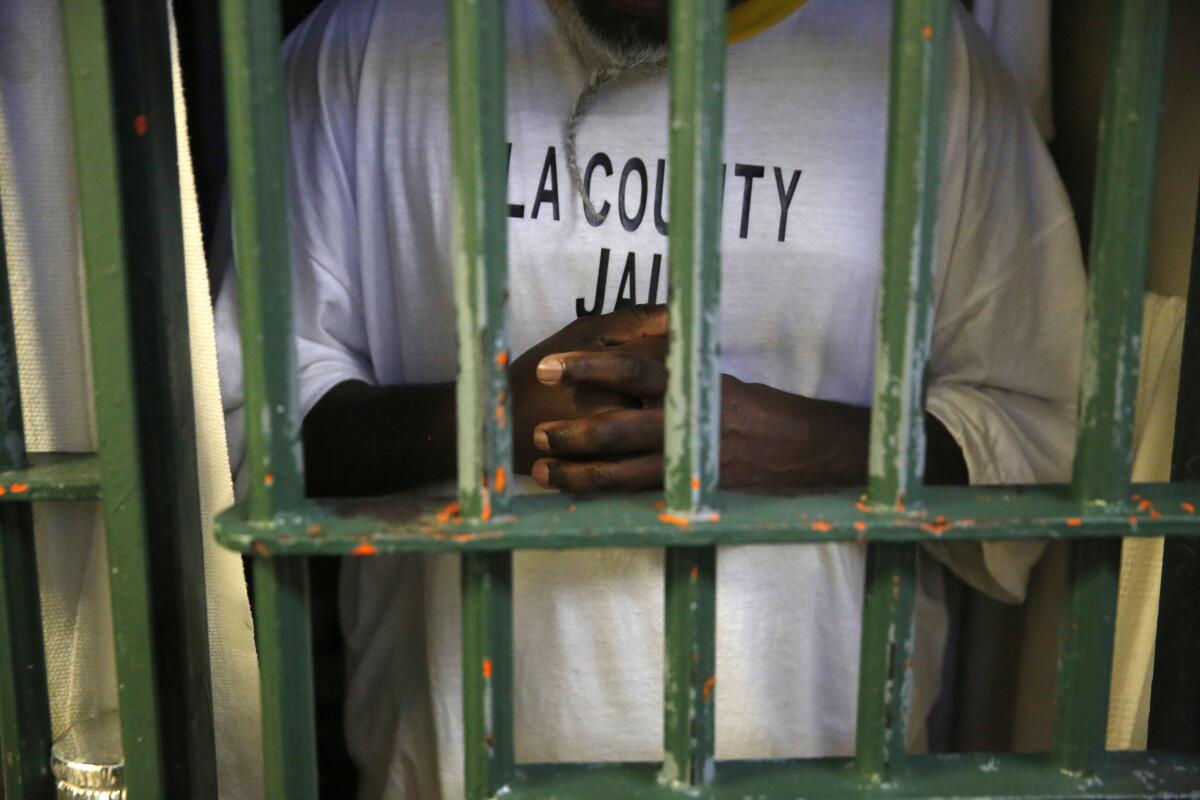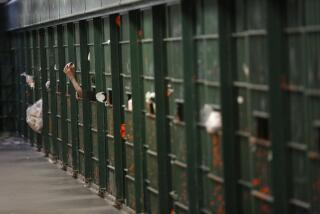Harvard study suggests tactic for U.S. jails to reduce inmate deaths

- Share via
County jails may be able to improve access to medical care and lower death rates behind bars through healthcare accreditation, according to new research by Harvard University economists — but the process still leaves inmates frustrated by low standards of care.
The Harvard study shared with The Times looked at 44 midsize jails across the country and found those that earned accreditation from the nonprofit National Commission on Correctional Health Care saw a 93% lower monthly death rate than those that didn’t. Over the course of the study, that reduction could have saved about 15 lives, the researchers said in a preliminary draft of their work, which has not yet been peer-reviewed.
Crystal Yang, a professor at Harvard Law School and one of the study’s co-authors, said jails that seek a stamp of approval from the NCCHC tend to better educate staff about referring inmates for treatment. The purpose is “making sure the processes and procedures for triaging and managing inmate patients are up to standard,” she told The Times.
The Los Angeles-based Anti-Recidivism Coalition, a nonprofit dedicated to ending mass incarceration, started a fundraiser on Friday to support the fire crews of California’s prisons.
Becoming accredited takes several months, usually costs $5,000 to $10,000, the Harvard researchers said, and typically involves a facility inspection by NCCHC experts. The jails in the study didn’t hire more staff, change healthcare providers or buy new equipment — but still saw lower death rates than the facilities that did not seek accreditation.
“They were able to provide services better with the capital and labor they had on hand,” said another study co-author, Marcella Alsan, a professor of public policy at the Harvard Kennedy School.
The researchers did not examine whether accreditation resulted in doctors seeing inmates more often, and said it did not result in facilities offering a wider array of services. But they said their findings suggest some healthcare services were offered more frequently and in a more timely manner at accredited facilities — such as intake medical and mental health screenings for new inmates.
Alsan said the accreditation process also spurred better communication between medical and correctional staff, improved compliance with safety and training standards, and boosted job satisfaction.
The research comes as jails across the country — including those in Los Angeles — have seen an uptick in deaths and growing criticism of conditions behind bars. In 2023, 45 people died in L. A. County lockups, driving the county’s jail death rate to more than twice what it had been a decade earlier.
The research does not include the names or counties of the jails that were included in the study, as they were guaranteed anonymity to participate. Nine of the jails were in California, but they all had average daily populations between 100 and 3,000, meaning the Los Angeles jails — which average around 12,800 inmates per day — were not included. The Los Angeles County Sheriff’s Department said in an email that its facilities do not have NCCHC accreditation.
The Harvard study contained some indications that accreditation is not a cure-all for troubled jail health systems.
One person died from a suspected overdose and two others were hospitalized, disrupting a murder trial and other court proceedings scheduled to proceed Friday despite fires burning in Los Angeles.
Staff at accredited facilities included in the research self-reported lower levels of respect for inmates than peers at non-certified jails. The inmates interviewed for the study offered dim views of the treatment they received regardless of their jail’s accreditation status.
“Medical staff assume you are lying [about health issues],” one inmate told researchers. The unnamed inmate added they didn’t think the poor level of treatment they’d received in jail — one of the accredited ones — “was possible in this country.” Similarly, an inmate at a facility that was not accredited told the researchers they were treated like “animals.”
In 2021, the researchers identified several dozen jails interested in participating in a study, then paid the costs for them to become accredited. For the next few years, the Harvard team interviewed staff and inmates, and surveyed the facilities as they went through the process.
Two of the jails initially in the study dropped out early on — in one case, because someone in the facility’s medical leadership team had a heart attack, and in the other case because someone in the facility’s custody leadership team was sued for sexual harassment. Of the remaining 44 jails, half were assigned to get accreditation and half were not. Eleven succeeded, and two others are on track to finish. Nationally, about 15 to 20% of jails are accredited, the researchers said.
The 13 jails that completed or will complete accreditation had a 18% higher rate of compliance with safety and prevention standards, and a 25% higher rate of compliance with personnel training standards, the researchers found. And while three people died in the 13 facilities on the accreditation track, their 22 non-accredited counterparts saw 27 deaths in the same time frame.
As to why they found such improvements in healthcare compliance and outcomes, the researchers suggested in a draft of their report that the bar is low to begin with: “It seems the magnitude of our effects are due to the fact that there is considerable scope for improvement among U.S. jails, where information frictions and coordination problems are severe and where health outcomes are much worse than widely believed.”
The dangerous problem of sleep deprivation leads to a health and safety crisis in prisons and jails.
In recent years, Los Angeles County inmates have died from jumping off railings, banging their heads against a wall and injecting drugs with makeshift needles, The Times has previously reported. At least three inmates died after stuffing paper, sanitary napkins or other items down their throats, asphyxiating before anyone intervened. One man died after he was beaten and left bleeding for four hours before guards noticed. A Times analysis of state and county data last year found that in Los Angeles jails, natural deaths, killings and overdoses were all up compared with 10 years ago.
But ultimately last year proved to be less deadly than the year before; by the end of 2024, the Sheriff’s Department reported that 32 people died in its custody, marking the jails’ lowest death toll since 2019.
More to Read
Sign up for Essential California
The most important California stories and recommendations in your inbox every morning.
You may occasionally receive promotional content from the Los Angeles Times.














